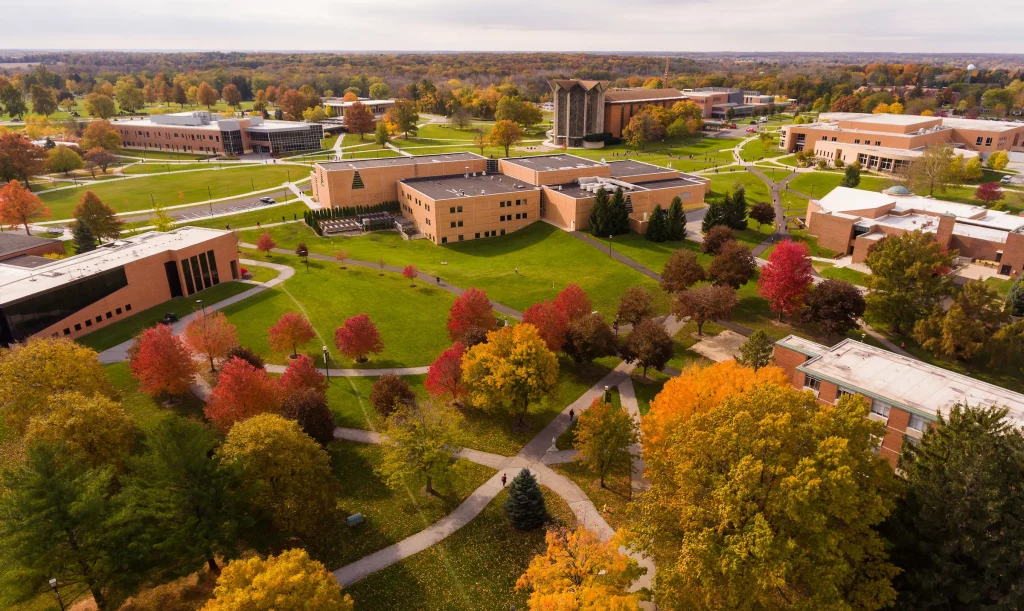Valpo Alumni Report on Historic Oklahoma Tornado
Michael Seger initially marveled as the storm developed in what the 2005 Valparaiso University graduate referred to as “textbook” fashion. Later, he watched in awe as a majestic tornado spun from the dark, low-hanging clouds and dropped from the sky, beginning a slow and eerie dance across the horizon.
But as the twister grew, churning away at the earth below it, Seger felt a pit form in his stomach. The heavily populated Oklahoma City suburb of Moore stood in the path of the monster storm. The realization had begun to set in for Seger — this was going to be devastating.
And it was.
Seger reported live for FOX23 News in Tulsa, Okla., on the afternoon of Monday, May 20. He and a storm-chasing team from the station followed the massive tornado as it marched across the countryside and into Moore, where it left historic destruction in its path, leaving 24 dead and injuring nearly 250 people.
“It’s the most violent tornado I’ve ever witnessed,” Seger said. “It was a sickening feeling.”
The tornado registered as an EF5 on the Enhanced Fujita scale, the highest rating possible for a storm, with winds peaking in excess of 200 mph.
Seger began his day by reporting the weather on the FOX23 morning show, where he predicted an active day with the potential for dangerous storms and possible tornado formation. Later, as he sometimes does after the morning shift, he and a crew took to the Oklahoma roads and chased storms.
Seger and his team came upon the Moore tornado after abandoning a chase of another storm that was weakening. This new storm, though, was strengthening.
“It just turned into a monster,” Seger said. “I couldn’t believe how quickly it went from a cone to a 1.3-mile wedge.”
Michael Grogan, a 2008 Valpo graduate, was north of Oklahoma City that afternoon, chasing storms for KOTV News On 6 out of Tulsa. As the tornado hit Moore, Grogan was chasing storms that also produced tornadoes. In all, there were 12 reported tornadoes in Oklahoma that day.
“It’s such a tragedy,” Grogan said. “We knew there was a threat that day, particularly for strong tornadoes. Unfortunately, we never hope or expect them to encounter a major population center like Moore and a city that has such an astonishing history with tornadoes.”
In 1999, a major tornado on a similar path killed 36 and injured nearly 600 and caused $1 billion of damage.
“As we were tracking our own tornado, I saw that tornado on the ground and I knew it would be taking people’s lives and property and sparing nothing in its path,” Grogan said. “It’s a horrifying feeling you get as a storm chaser to see something so fascinating and powerful that has such a dramatic impact.”
Both Seger and Grogan studied in Valparaiso University’s renowned meteorology program. And both took part in the meteorology program’s Convective Field Study, which takes members of the Valparaiso University Storm Intercept Team on a storm-chasing tour each spring and summer of Tornado Alley in the Great Plains. Valpo’s Storm Intercept Team left campus Monday and is currently conducting studies in the Plains.
“Storm chasing at Valpo produced some of my most memorable times,” said Grogan, who took part in two storm-chasing trips as a student. “Valpo is very dear to me.”
Seger enrolled at Valpo after earning a degree in computer art from the Savannah College of Art in Georgia. He grew up with a love of meteorology, but at Valpo that love flourished into a vocation.
“I felt like by learning from Bart [Wolf, associate professor of meteorology,] and Teresa [Bals-Elsholz, chair of the Department of Geography and Meteorology], you could feel their passion for weather,” Seger said. “It made your passion grow even more.
“I loved every minute of my time at Valpo. I tell people my choice to attend Valpo was the best decision ever made in my life.”
To assist the victims of the tornadoes, donations are being accepted through the Red Cross, the Evangelical Lutheran Church in America, and the Lutheran Church-Missouri Synod.
